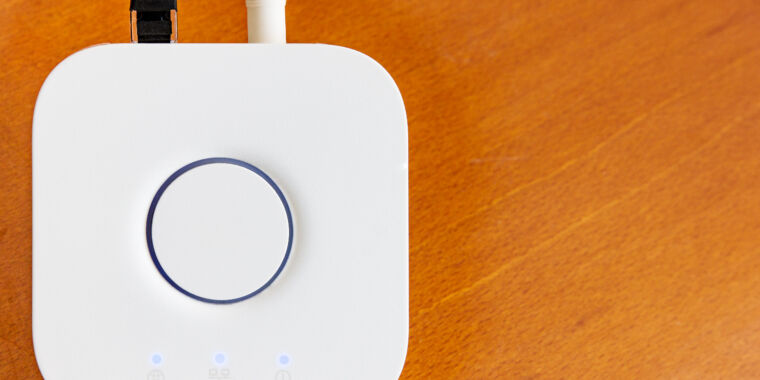cross-posted from: https://feddit.uk/post/7783032
When I started at Ars in the summer of 2022, the next generation of smart home standards was on the way. Matter, an interoperable device setup and management system, and Thread, a radio network that would provide secure, far-reaching connectivity optimized for tiny batteries. Together, they would offer a home that, while well-connected, could also work entirely inside a home network and switch between controlling ecosystems with ease. I knew this tech wouldn’t show up immediately, but I thought it was a good time to start looking to the future, to leave behind the old standards and coalesce into something new.
Instead, Matter and Thread are a big mess, and I am now writing to tell you that I was wrong, or at least ignorant, to have ignored the good things that already existed: Zigbee and Z-Wave. I’ve put in my time with Wi-Fi, Bluetooth, and various brittle combinations of the two. They’re useful for data-rich devices and for things that can stay plugged in. Zigbee and Z-Wave have been around, but they always seemed fidgety, obscure, and vaguely European at a glance. But here, in the year 2024, I am now an admirer of both, and I think they still have a place in our homes.
What does “vaguely European” even mean?
That’s how I’d describe Tommy Wiseau or John Waters lol
Gillian Anderson in her later career also.
I would have never thought about it, but somehow you’re exactly right.
Haha, I have no idea. Possibly less corporate, more “small, simple, open system that others can contribute to”.
I can only speak in vagueness on the “european-ness”, to be honest.
HASS/Zigbee have an open, european feel to me.
HomeSeer has a very american “this is the way we’re doing it, it costs this much” feel.My mind went to IKEA-like with a funny name and modern styling.
But I have no idea if that’s what the author meant.
I had the same thought. Is it an insult?
I don’t think so.
I think it just means they seemed like standards which were more prevalent in Europe, meaning support might be better for Euro hardware, or that the (presumably) American market was leaning in a different direction.
A wall plug came with a Schuko adapter…
What i have a problem is the developer accessebility.
I want to build my own sensors into boards and use those, but the devboards are so expensive, its not worth it.
A board with an esp8266 costs just 1-2€, with zigbee its 20-25€.
Might aswell go for the new esp32 versions now and use thread… and its still cheaper.
(though that wasnt an option a few years back, best option there was esp-mesh which kinda sucked)esp32-c6 (supports zigbee), is pretty cheap.
If only ESPHome had support for Zigbee on the C6 and H2. So much potential for cool projects.
I agree, I’d be picking up a bunch of those, if that were the case.
I’ve never actually tried doing dev on a zigbee board. A cursory glance puts them at £6.
But I can absolutely understand why ESP is so much more popular. Which is a shame, as I like not having to mess with wifi/BLE.Try getting a Zwave devboard 😅
ZigBee and Z-Wave are awesome because they stay functional irrespective of:
- WiFi
- Router
- Internet
- Cloud
So long as the Home Assistant is alive, everything works. The reliability and uptime approaches the AC mains.
And they allow for battery powered devices to have multi-year battery life.
The internet and cloud points are my favorite. Specifically the fact that those things are out of the picture.
No VLAN configuration necessary. The hub is “the VLAN”. They literally can’t phone home because they have no route to the internet, with no extra setup necessary. For WiFi devices, I have to make sure they’re connecting to the right VLAN and controlled properly, and if I misconfigure something, they are phoning home or joining a botnet.
(This stops being as applicable if you have a sketchy hub you don’t trust, but I trust deconz and ZHA fine enough in this context).
Same here. Not having a path to the internet by default is lovely. Local data stays local without any extra config.
Exactly. Which allows you to use devices from any vendor without having to worry about the preloaded botnet agent. 🤭
Until Zigbee2MQTT breaks again ;P
Using ZHA for a year and a bit. No breakage so far. Knocks on wood.
ZHA isn’t compatible with a lot of recent Hue bulbs. It’s a bit frustrating.
Oh really, like what? I have a few E26 models and two strips. I haven’t tried any others.
Specifically: https://www.amazon.com/gp/aw/d/B095KSZQGD?psc=1
And
https://www.amazon.com/gp/aw/d/B0BCHBXZ8D?psc=1
And several of the a19 and br30 models.
If you scroll to the Phillips hue list on ZigBee.blackadder.com, you’ll see the lack of ZHA support.
deleted by creator
I found hue bulbs to be a lot more responsive once I ditched the hub, and paired my bulbs directly with a zigbee coordinator.
This is the way. I’ve had absolutely zero issues with my Hue bulbs directly connected to a USB Zigbee controller and running zigbee2mqtt. With Zigbee bindings to smart switches, they respond practically instantly as well whenever we decide to control them that way.
I used to use a USB Zigbee coordinator, but an Ethernet one with PoE is way more flexible since I can place it anywhere in the house. https://smartlight.me/smart-home-devices/zigbee-devices/smlight-slzb-06en. This one has a nice web UI for updating the firmware, too. I switched from a Sonoff Zigbee dongle recently and really should have done it earlier.
As someone who runs HomeAssistant in a VM that could migrate between three different servers at anytime depending on what is going on, a networked Zigbee coordinator was essential.
Eh, just stick the USB into a pi and host the usb port over the network into the vm.
That’s just a networked Zigbee coordinator with more steps. The coordinator I linked to uses PoE so all I need is a network cable.
sure, but I don’t have to buy more things that I already have… and can do it with zwave too.
That does also look like a good option. In my case, I have a Pi 4 running both zigbee2mqtt and zwave-js-ui using connected Zigbee and Zwave USB dongles placed centrally in the house (Eclipse mosquitto is running on a separate 3-server cluster). I’ve only briefly searched, but network zwave controllers seem to be much less common or more expensive, so I probably wouldn’t benefit much from changing my Zigbee controller at the moment.
The Zigbee ones aren’t too expensive. The one I use (Smartlight SLZB-06) is $30 plus shipping ($8 to the USA) from their official store.
Z-wave is more of a niche at this point, especially since newer Zigbee radios also support Thread (which is the future).
Oh I know, but my thermostat and a handful of other devices are Zwave, so for me specifically it’s probably not worth changing things up at this time.
I’ve had next to zero issues with my Hue setup. It’s performed near flawlessly.
deleted by creator
I’m glad you have luck with govee lights. The controllers on the strips I have need to be reconnected to wifi 2-3x a week. They’re a total pain for me.
I have a bunch of stuff in my Amazon cart ready to convert the strips to wled. Very much looking forward to bot having to deal with them anymore
Try changing your Zigbee channel. I had awful performance until I tried that. Not always perfect now but WAY better.
I had a dual-hub setup, with ~60 bulbs. I was running close to the max device limit of one so I had to add another. The only issues I’ve had were with a particular model of bulb. The A21 1600lm white. A fifth of the bulbs developed hardware problems which resemble control issues in some but they really are much more serious. They begin to self power cycle. Some eventually die and don’t turn on anymore. Some get loose elements inside. All of that says excess heat. Apart from the problems with this particular bulb I’ve had no problems whatsoever.
Still hopeful that matter and thread get ironed out. It’s the standardization the systems need: no more “download tuya to install”
-
Offline control
-
standardized setup
-
Low energy optimized
Currently I have to run a few different bridges to keep everything happy. Zigbee2mqtt is definitely my most used.
It’s funny, I’m eyeing up an air conditioner atm.
And the one I’m focussing on looks pretty special, not because it runs tuya, but because absolute gods in the FOSS community have made a complete alternative firmware for it that works with HASS directly on the tuya host hardware.Which air conditioner? Sounds like a gem.
This is the github for it.
Honestly, I’m half expecting the version I eventually get not to be compatible!That is the way of Tuya unfortunately…
Don’t download Tuya. 😂
correct
If a smart home app is required I’m out
-
I still don’t understand what theoretical advantage it has over x10 for things that are plugged in. (In practical terms the HA support for X10 was apparently pretty bad last time I looked)
I have been doing home automation for almost 30 years. I started with x10, and still have a few x10 devices deployed in my house, so I think I’m in a position to know what I’m talking about here.
There are a few major advantages Zigbee and Zwave have over x10, namely:
- The Zs are fast. X10 takes a quarter to half a second at best to travel through the house and activate the device. If there is noise on your powerline, it takes longer. Sometimes messages are missed. This is old tech, and there isn’t a lot of error correction or signal ack.
- Phase Bridge. X10 uses your house power line to send signals. You may or may not know this, but (at least in the US) your power is split into one or more electrical phases. The X10 signals are absolutely terrible at crossing from one phase to the other, and it isn’t always obvious when you plug something in which phase that outlet is on. This leads to a lot of troubleshooting. Things like phase bridges exist to solve this, but they aren’t terribly reliable.
- Wireless. The Zs don’t need to be connected to your powerline to function. There are no powerline x10 devices that run on batteries for obvious reasons. This allows for a lot more versitility.
- No setting house/device codes. If you have ever actually used X10, you know each device has its own house and device code that needs to be selected (usually with a tiny screwdriver while crawling on the floor in the dark, but I digress). This is all handled digitally and is more or less plug and play with zigbee and zwave.
- Encryption. Any idiot with an extension cord and some free time can connect to a power jack on the outside of your home and turn whatever they want on and off with X10. There is no authentication whatsoever. Ironic, considering the company most known for X10 devices sold security equipment.
Now there do exist some wireless battery powered x10 devices (the MS16A motion sensor, for example or the DS10A door sensor). These are actually fairly solid devices, and I still use a good number of them in my home. (I have many DS16As that have been in daily use for more than 20 years)
It isn’t all bad, and there is no reason to throw it all out if it works for you. However, if you are buying new gear to automate with, there isn’t really a compelling reason to go back to X10. the modern solutions are cheaper, faster, more secure, and easier to work with.
I’ve never really looked into X10.
A very brief look suggests that the signaling goes over the mains cables? If that’s correct, then the big thing for me would be that it separates the communication from mains electricity. Most people don’t like messing with 240v, unless they absolutely have to.
Which would mean more needs to be done by an electrician.I don’t know about theory, but the big practical advantage to ZigBee is that it works.
Sorry, that’s a shitty thing to say. I’m salty because the only time I tried X10 was 25 years ago, and the experience was less than great. Unreliable switching, spurious commands, slow performance, etc. Sending signals over the power wires sounds great in theory, but in practice there are all sorts of pitfalls, like resistive versus inductive loads, bridging circuits to different legs of two-phase power, or conflicting commands on the wire.
ZigBee has just worked for me, since it avoids all of the potential wiring issues. You just plug a device in, put it in pairing mode, and Home Assistant finds it, interrogates its capabilities, and adds it (by name) with the correct entities. No mucking about with addresses, or adding signal paths to the house wiring. As a mesh network, it’s quite robust, since most plugged-in devices act as repeaters.
The downside of ZigBee, of course, is that it may not work well in WiFi-saturated environments, since it uses the same 2.4GHz frequency band.
Yeah, this is pretty much what I gathered.
As an EE I love the theoretical elegance of using the wires that are already there for communication, but the practical implementation seems to be an issue.
@SwingingTheLamp @RobotToaster yes. All this
@RobotToaster @GreatAlbatross oh man, X10 was such junk. Terrible reliability, expensive, clunky. Always awkward as the units plugged into receptacles with little positioning flexibility, and a restrictive ecosystem with inflexible players tying it up in patents for so long. A couple of hundred bucks I blew there was totally wasted …about 20yrs.
Matter and Thread aren’t being forced because they think consumers don’t care enough to wait. There are too many people who will just buy “smart” anything, without regard to which proprietary app they need to install.
The market is there. Look at Nanoleaf sales.













